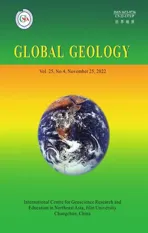Characteristics of source rocks and paleoenvironment of Lower Silurian Longmaxi Formation in western Hubei
2022-12-07WANGNengDUJiangfengLIURongZHANGKunYANXuandLIUGaofei
WANG Neng, DU Jiangfeng, LIU Rong, ZHANG Kun, YAN Xu and LIU Gaofei
1. College of Earth Sciences, Jilin University, Changchun 130061, China;
2. CNOOC Research Institute Co., Ltd., Beijing 100028, China;
3. School of Geographical Sciences, Northeast Normal University, Changchun 130024, China
Abstract: Based on feild outcrop survey, lithology observation and systematic sampling, and with the scanning electron microscope, rock pyrolysis, biomarker compound test and analysis, this paper discussed source rock characteristics and paleoenvironment in western Hubei. The lithology at the bottom of Lower Silurian Longmaxi Formationn in this study area is mainly dark carbonaceous shale, the mineral composition is mostly clay minerals, quartz and feldspar, the content of illite and kaolinite is high, but also contains a minor amount of strawberry pyrite and graptolite fossils. The test and analysishow that the total organic carbon content (TOC) of the source rock is 0.8–6.32%, the average value is 3.42% , and the vitrinite reflectance (Ro) is 1.57–2.95%. The type of organic matter is mainly type Ⅱ2. The overall abundance of organic matter is high,and the degree of thermal evolution has reached the stage of high maturity and over maturity. All these have become the good material basis and conditions for the formation of shale gas. The paleoenvironment of the source rocks indicates that the organic matter is a mixed source of planktonic algae and bacteria material.The large amount of hopane also indicates that the bacterial activity is strong during the deposition of organic matter; The water of the ancient lake is almost freshwater and brackishwater in some parts; The redox property of the water is in a strong reduction environment and with a stable stratification, which is also conducive to the preservation of organic matter. The above research results will provide the application of shale gas exploration in western Hubei.
Keywords: source rock; organic geochemistry; paleoenvironment; western Hubei; Longmaxi Formation
Introduction
A set of Ordovician-Silurian marine black graptolite shale has been widely deposited in the Yangtze region of China (Zouet al., 2010), and the Lower Silurian Longmaxi Formation is a better shale gas exploration and Development Series in the middle Yangtze Region (Guoet al., 2016; Zouet al., 2016;Huet al., 2019). At present, a lot of research is mainly concentrated in southern Sichuan and southeastern Chongqing. Three large shale gas fields of Weiyuan,Changning and Fuling have been found in this series,and Fushun Yongchuan, Pengshui and other shale gas producing areas have been formed (Chenet al.,2020). The research degree of this stratum is relatively low in western Hubei, but the Longmaxi Formation of Lower Silurian is widely developed in western Hubei of middle Yangtze, with shale development and high organic carbon content. It is also an important stratum for shale gas exploration in the future. The development of high-quality shale gas source rocks often depends on good sedimentary paleoenvironment.Through the analysis of the characteristics of source rocks, this paper intends to deeply reveal the source of organic matter, ancient lake redox and salinity paleoenvironmental conditions in the study area, so as to provide a certain theoretical research basis for the exploration and development of shale gas in Longmaxi Formation of Lower Silurian in western Hubei.
1 Geological setting
Western Hubei is geographically located in the west of Hubei Province, the southeast of Chongqing,the northwest of Hunan Province and the south of the Yangtze River (Xuet al., 2020). The west is adjacent to Sichuan Basin, the east is bounded by Tongchenghe fault zone (F5), the north is bounded by Yangri fault zone (F3), and the south is adjacent to Jiangnan Xuefeng nappe uplift zone (Xuet al., 2020; Zhong, 2019).The region has successively experienced multistage complex tectonic movement faults such as Caledonian,Hercynian, Indosinian and Yanshan(Zhuet al., 2008).The faults are developed in an oblique manner,mainly in the northwest and east-west directions. The reverse faults include Qiyueshan fault (F1), Xinhua fault (F4) and Yangri fault (F3), while Enshi fault (F2)and Tongchenghe fault (F5) are normal faults (Xuet al., 2021). The study area is exposed from Paleozoic,Mesozoic and Cenozoic. The study area is mainly distributed in Lichuan syncline(B1), Huaguoping syncline zone(B2), Changyang syncline(B3), Yidu-Hefeng anticline zone(B4) and the periphery of Shennongjia anticline(B5) (Fig.1). The strata are fully developed, and the Silurian strata are widely exposed in the study area. The lithology of the lower part of Longmaxi Formation is mainly dark carbonaceous and siliceous shale, with a small amount of siltstone interlayer, and some areas are rich in graptolite. The lithology in the middle part is mainly grayish black,grayish green shale or carbonaceous shale, intercalated with siltstone and silty shale. The upper lithology is mainly gray and grayish green silty shale, intercalated with sandstone and siltstone.
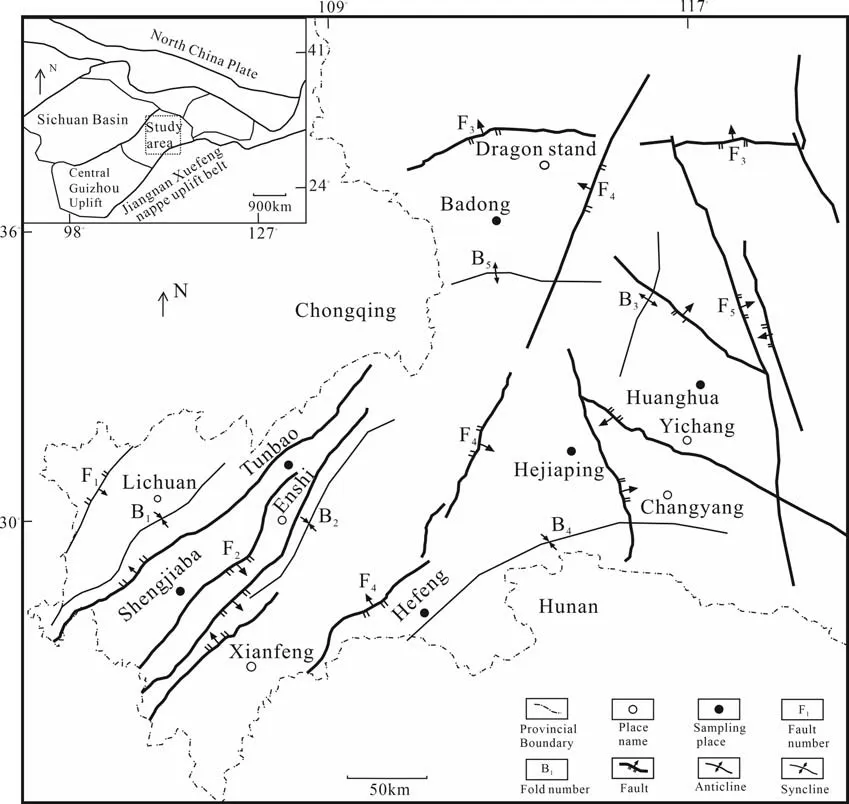
Fig.1 Sketch map showing sample location in wectern Hubei (after Xu et al., 2020)
2 Materials and methods
The strata in western Hubei are relatively well developed, and the Lower Silurian Longmaxi Formation has good outcrops in the field. Guochangwan, Zhongying Town, Gongjiaya, Wuyang Township, Xialuoping Village, Lucongpo Town, Badong Area, Laowuchong Village, Hejiaping Town, Changyang Area, and Huanghua Town, Yiling District, Yichang Area, etc.A total of 27 fresh rock samples of the Longmaxi Formation in the target layer were collected through field reconnaissance and systematic sampling.
The tests of total organic carbon, rock pyrolysis,organic macerals and biomarkers related to the paper were completed in the Key Laboratory of oil shale and symbiotic energy minerals of Jilin University, the scanning electron microscope test was completed in the research center of Paleontology and stratigraphy,and the organic element analysis experiment was completed in the geochemical Laboratory of Changjiang University. The total organic carbon was measured by LecoCS230 carbon sulfur instrument,Rock-Eval6 pyrolysis instrument and JSM-6700F scanning electron microscope; The determination of biomarkers was completed by GC-MS and other sub mass spectrometers. Organic matter extraction and group component separation were carried out before biomarker analysis, and organic matter extraction was completed by ASE200 accelerated dissolution extractor.
3 Petrological and mineralogical characteristics
3.1 Petrological characteristics
The maximum thickness of rock stratum of Longmaxi Formation can reach 830 m. The lithology is mainly a set of dark gray carbonaceous mudstone,gray black carbonaceous siltstone and gray black carbonaceous shale (Fig.2a, b). The bottom horizon is rich in organic shale, and the thickness is generally between a few meters and tens of meters. In the organic rich shale, the horizontal bedding is developed and bioaccumulated into layers, mainly graptolites and algal fossils (Fig.2c, d).Graptolite fossils are mainly concentrated in the gray black and black shale at the bottom of Longmaxi Formation, and the graptolite content decreases gradually from bottom to top vertically. Under the microscope, horizontal laminae can be observed in shale, mainly composed of clay laminae, felsic laminae and organic laminae, but the former two are mainly (Fig.2e, f).
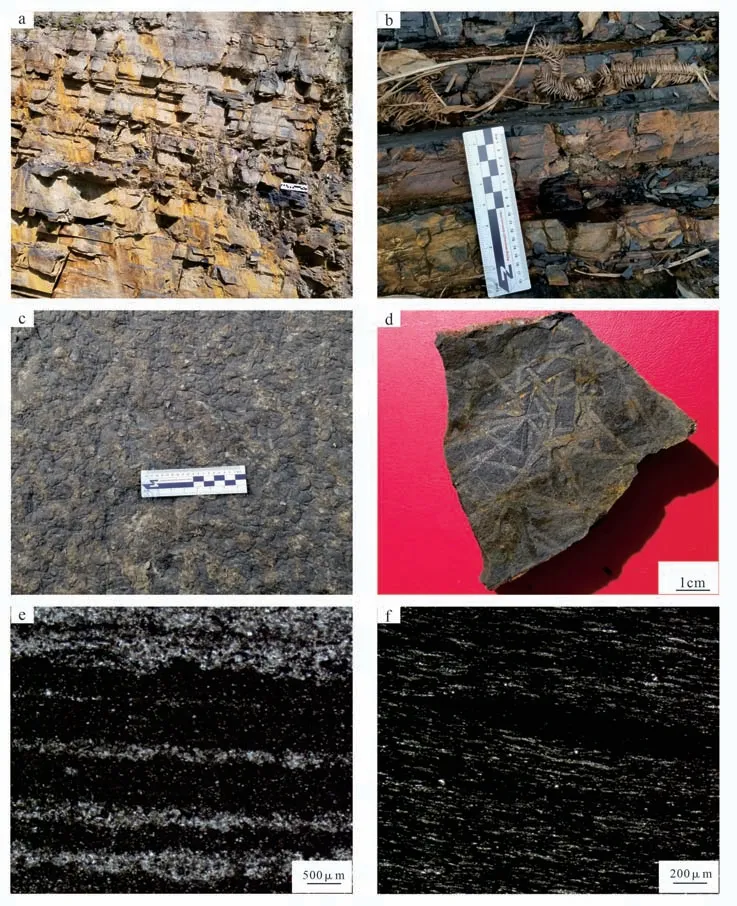
Fig.2 Field petrological characteristics and microscopic characteristics of Longmaxi Formation in western Hubei
3.2 Mineralogical characteristics
The SEM photos of different lithologic samples in the study area show that (Fig.3), the main components of shale are quartz, feldspar (Fig.3d),clay minerals and pyrite (Fig.3c). Clay minerals are mainly illite (Fig.3b) and kaolinite (Fig.3a). Under the microscope, kaolinite is generally in plate shape and laminated. Kaolinite in the study area is mostly in plate shape, and the degree of self-shape is generally high. There are Si, Al, Mg and O peaks and no K peak in energy spectrum analysis (Fig.3a). Illite is difficult to see its single crystal under the microscope, mostly in aggregate form, mostly in hair filiform, and some in flake form. Illite in the study area is mostly distributed in filamentous shape, and there is one more K peak in illite compared with kaolinite by energy spectrum analysis (Fig.3b). Under the microscope, round and sub round feldspar can be observed, strawberry pyrite is relatively developed, and two peaks of Fe and S can be seen in the energy spectrum (Fig.3c).

Fig.3 Mineralogical characteristics of Longmaxi Formation in western Hubei under scanning electron microscope
4 Characteristics of source rocks
4.1 Organic matter abundance
In this paper, the organic matter abundance of source rocks in the study area is analyzed by using organic carbon content (TOC), chloroform asphalt “a”and total hydrocarbon (HC) content and rock pyrolysis hydrocarbon generation potential. According to the geochemical index evaluation table of petroleum generation potential of source rocks proposed by Magoonet al.(1991) and the evaluation standard of organic matter abundance of Chinese marine source rocks (Peterset al., 1994), the hydrocarbon generation potential of rock pyrolysis, chloroform asphalt “a” and total hydrocarbon test data show that the source rocks of Longmaxi Formation in western Hubei belong to non-source rocks. However, the TOC content of the sample is 0.8%–6.32%, the average value is 3.42%,and the highest TOC value is 6.32%, which belongs to high-quality source rock. The main reason for this contradiction is that the thermal evolution degree of the source rocks of Longmaxi Formation in western Hubei is high, reaching the high over mature stage. A large amount of organic matter in the source rocks generates hydrocarbon and has undergone the migration process of hydrocarbon expulsion, resulting in abnormal characteristics of pyrolysis, chloroform asphalt “a” and other data (Wuet al., 2020; Zhaoet al., 2021).
Combined with a large number of previous studies,when the degree of thermal evolution of organic matter is high, most of the indicators to evaluate the abundance of organic matter have failed, but the organic carbon content (TOC) is still an effective evaluation index. Lianget al. (2008) divided indicators for this evaluation, and adopted TOC=0.5% as the lower limit of organic matter abundance of source rocks.According to the TOC distribution map of the study area (Fig.4), it shows that most of the samples belong to good source rocks and very good source rocks, and a few belong to excellent source rocks.
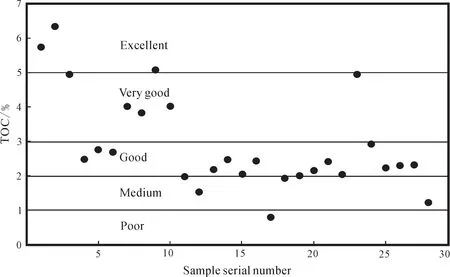
Fig.4 TOC distribution of source rocks of Longmaxi Formation in western Hubei
4.2 Type of organic matter
The type of organic matter is one of the important parameters for evaluating the hydrocarbon generation potential of source rocks. Conventional test indicators include kerogen element analysis, hydrocarbon generation potential (S1+S2), hydrogen index (HI),chloroform asphalt “a” and so on (Wuet al., 2020).However, for the identification of organic matter types of high over mature source rocks, these conventional indicators have failed (Zhaoet al., 2021). As the degree of thermal evolution of source rocks increases,the evolu tion results of various organic macerals tend to be consistent, but there are still great differences in the optical properties of different components(Zhanget al., 2008). Therefore, the organic matter types of high over mature source rocks can be divided by organic petrology, generally using T index method (Jiet al.,2007). Through the identification of organic macerals,count the contents of different macerals in kerogen,and calculate and determine the type of kerogen: T=(100A+50B–75C–100D)/100. In the formula, the percentage contents of A, B, C, D-sapropelic group,exinite, vitrinite and inertinite.
The types of kerogen can be distinguished according to the size of T Index: if T value is greater than 80, it belongs to type I kerogen (sapropel type), if T value is between 80 and 40, it belongs to type Ⅱ1kerogen (saprolite-sapropel type), if T value is between 40 and 0, it belongs to type Ⅱ2kerogen (saprolitesapropel type), and if T value is less than 0, it belongs to type Ⅲ kerogen (saprolite type). Substituting the data into the above formula to calculate and draw the distribution map of T value (Fig.5), it shows that the organic matter type of Longmaxi Formation source rock in Western Hubei is mainly type Ⅱ2kerogen (Table 1).

Table 1 Kerogen maceral content and types of source rocks of Longmaxi Formation in western Hubei

Table 2 Classification standard of mature stage of black shale in southern China (after Nie, 2005)

Fig.5 T value and organic matter type of Longmaxi Formation in western Hubei
4.3 Maturity of organic matter
At present, the commonly used parameters for detecting the maturity of organic matter in source rocks include vitrinite reflectance, sporopollen carbonization degree, thermal change index, rock pyroly-sis parameters, carbon dominance index (CPI) and conodont color change index (CAI) (Zhaoet al.,2016). Silurian lacks higher plants (Wanget al., 1994),so it is difficult to measure vitrinite reflectance, so it not be used as an index to judge maturity. There are a large number of widely distributed asphalts in the source rocks of Longmaxi Formation in Western Hubei. In recent years, geologists and geochemists at home and abroad have carried out a large number of experimental studies on the relationship between asphaltum reflectance (Rb) and vitrinite reflectance(R0), and put forward representative formulas such as Feng Guo and Chen (1988). In recent years, Xieet al.(2016) and others have proposed a new conversion formula based on the formula proposed by predecessors, which is widely used as follows. R0=0.2177+0.7172 Rb(high over mature stage).
The test result of asphalt reflectance (Rb) of source rock samples of Longmaxi Formation in Western Hubei is 1.9–3.84%, and the average value is 3.01%. By substituting the above formula, the distribution range of vitrinite reflectance (R0) is 1.57–2.95%. The paper draws the intersection diagram of standard car-bon preference index (CPI) and odd even dominance (OEP)(Fig.6) and Romaturity distribution diagram (Fig.7).According to the classification standard of black shale maturity stage in southern China (Lieet al., 2012)(Table 2), the experimental data analysis shows that the organic matter of Longmaxi Formation in western Hubei has entered the high maturity over maturity stage.
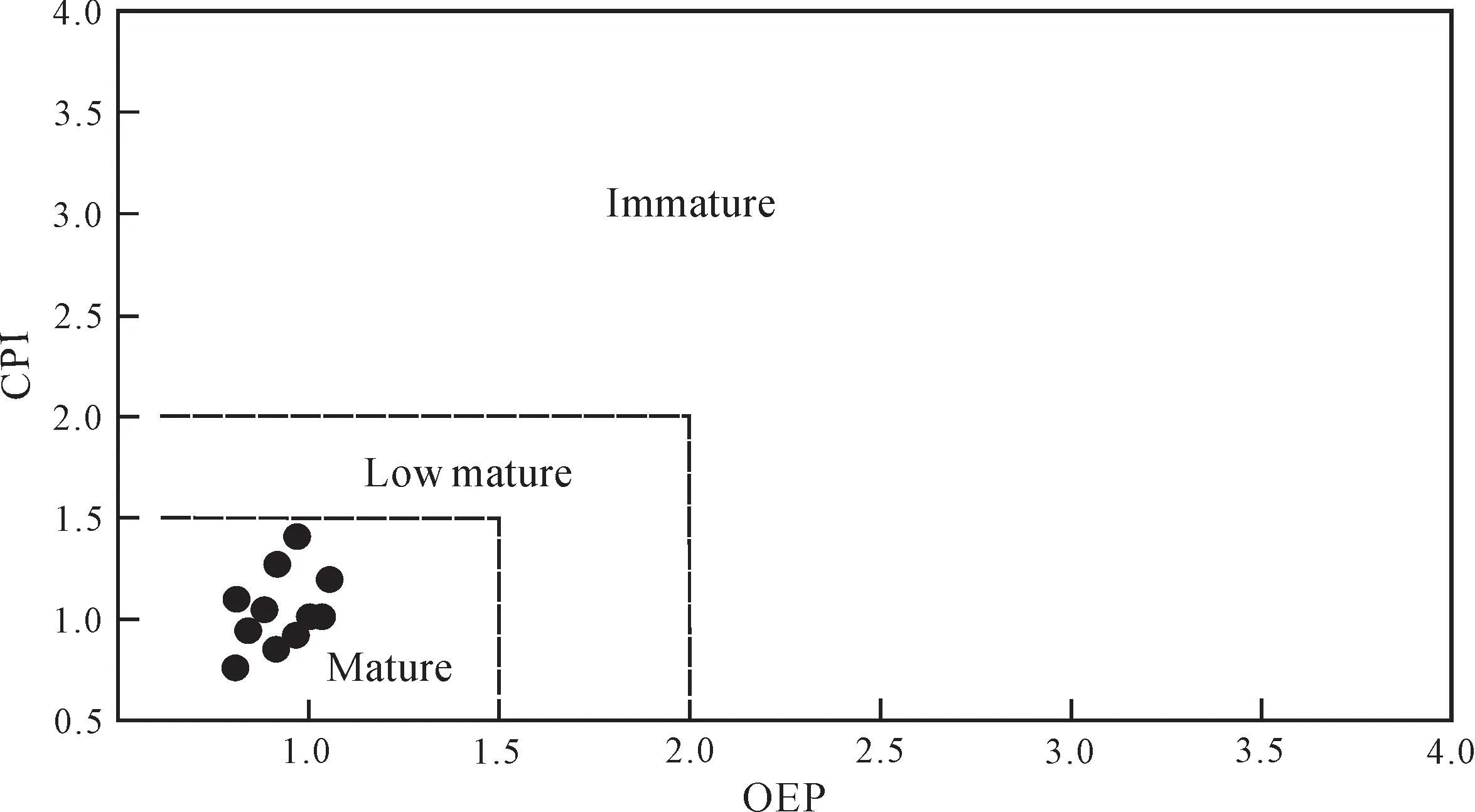
Fig.6 Intersection of standard carbon preference index (CPI) and odd even advantage (OEP) in western Hubei

Fig.7 R0 maturity division of Longmaxi Formation in western Hubei
5 Paleoenvironment analysis
5.1 Source of organic matter
Lake sediments contain rich geological information such as organic matter evolution, climate environment, Lake biological activities and physical and chemical properties of lake water. They have become one of the important research carriers of paleoclimate and paleoenvironment (Lieet al., 2012; Lanet al.,2022), in which the source of organic matter is the focus of paleoenvironment research. Based on the field samples of source rocks of Longmaxi Formation of Lower Silurian in western Hubei, the source of organic matter in this area is analyzed by using the test data of organic macerals and biomarkers.
5.1.1 Indicative significance of organic macerals
The type of organic matter is one of the main factors in the source analysis of organic matter (Liuet al., 2010). Generally speaking, type I kerogen mainly comes from lower aquatic organisms, algae and bacteria in the lake environment, type Ⅱ kerogen is a mixed source of aquatic organisms (plankton and microorganisms, etc.) and terrestrial plants (crustaceous group), and type Ⅲ kerogen comes from terrestrial higher plants (Zhu, 2010; Tissotet al., 1974). By substituting the kerogen maceral identification data into the T index formula, it is concluded that the organic matter types of the samples in Western Hubei are mainly type Ⅱ2and type Ⅱ1, indicating that the source of organic matter is mainly the mixed source of aquatic organisms (plankton and microorganisms) and terrestrial plants (exinite).
5.1.2 Indicative significance of biomarker compounds
Among the biomarkers of source rocks, isoprenoid alkanes are more stable than normal alkanes. They are used to indicate the redox sedimentary environment,but they often reflect the source of organic matter(Zhonget al., 2020). The Pr value of source rock samples of Longmaxi Formation in the study area is between 0.46–0.98, with an average value of 0.63, Ph value is between 0.22–0.45, with an average value of 0.34, and Pr/Ph ratio is between 0.58–1.78 (Table 3),showing the characteristics of low peak Pr and high Ph (Fig.8a). According to the intersection diagram of the two (Fig.9), the source of organic matter in the samples of Longmaxi Formation in the study area is mainly the mixed source of terrestrial plants and aquatic organisms, and has suffered a certain degree of biodegradation.

Fig.9 Intersection of Pr/nC17 and Ph/nC18 of LongmaxiFormation in western Hubei (after Alias, 2012)
Steranes widely exist in modern organisms. It is generally believed that bacteria and algae are rich in C27steranes, and C29steranes indicate that organic matter comes from terrestrial higher plants (Chenet al.,2001), but there is no unified understanding of the source of C28at present. C27, C28and C29steranes show an asymmetric “V” distribution in the gas chromatography mass spectrometry (Fig.8b). The C27/C29steranes ratio is between 0.77–1.38, and C27-29steranes are absolutely dominant in the sample (Table 3), showing the characteristics of terrestrial higher plant input(Menget al., 2006). Because there were no terrestrial plants before Devonian, Chenet al.(2001) The study shows that C27, C28and C29steranes in rocks and crude oil before Devonian only come from algae, and the different distribution of these three steranes is caused by the input of different algae. Subsequently, Menget al.(2006) did a lot of research on the biological source of Early Paleozoic source rocks, and believed that when C27-29sterane distribution was dominant, it was mainly input by planktonic green algae. Therefore, combined with the comparison of C27, C28and C29steranes in the organic matter of source rocks of Longmaxi Formation in western Hubei, the author believes that the distribution advantage of C27-29steranes in steranes series is not necessarily due to the input of terrestrial plants, but may be caused by the differential input of planktonic green algae. According to the ternary diagram of C27, C28and C29sterane relative content (Fig.10), it shows that the organic matter in the source rock samples of Longmaxi Formation in western Hubei comes from plankton, that is, planktonic green algae.

Fig.10 Longmaxi Formation in western Hubei Ternary diagram of ααα C27-C29 (20R) sterane relative content(Yandoka., 2015)

Table 3 Partial organic geochemical data of Longmaxi Formation in western Hubei

Fig.8 Saturated hydrocarbon TIC and m/ Z217 mass chromatogram of Longmaxi Formation samples in western Hubei
Hopane was detected in the samples of Longmaxi group (Fig.8c). Hopane is derived from the bacterial huotetranol that forms the bacterial cell membrane.The content of hopane can indicate the activity of bacteria (Tissotet al., 1973). To sum up the organic macerals, isoprene alkanes and steranes indicate that the organic matter in Longmaxi Formation is the mixed source of planktonic green algae and bacteria,and the large amount of hopane in the sample also indicates that the bacterial activity is strong during the deposition of organic matter.
5.2 Redox environment of ancient lake
It is considered that high Pr/Ph value indicates the oxidation sedimentary environment, and low Pr/Ph value indicates the reduction sedimentary environment. It is generally believed that Pr/Ph less than 1 indicates a reduction environment, and Pr/Ph greater than 1 indicates a partial oxidation environment(Li, 1999). The Pr/Ph ratio of Longmaxi Formation in this area is between 0.58–1.78, with an average value of 1.07 (Table 3), indicating that the study area is in the condition of reducing water body during the deposition period.
Gammacerane comes from tetrahymenol in protozoa (Zhang, 2021). It is found that the content of gammacerane in high salinity environment is not necessarily high, and high content of gammacerane can also appear in samples in freshwater environment.Previous researchers believe that ciliates in the stratified environment of lake water body are an important source of gammacerane, while density stratification of water body is often formed in the high salinity water environment (Ping, 1999). Through the correlation between gammacerane index and Pr/Ph, it can be seen that they have a certain negative correlation (Fig.11), that is, the lower Pr/Ph value corresponds to the higher gammacerane index, it shows that the water salinity stratification formed under the condition of higher salinity can form a stronger reduction environment.

Fig.11 Correlation between gammacerane index and Pr/Ph of Longmaxi Formation in western Hubei
According to Huanget al. (2011), the sedimentary environment will affect the ratio change of Ts/(Tm+Ts) (Ts is trinornehopane, Tm is trinorhopane)(Fig.8c). Generally, when the deposited eh (oxidation environment) is high, the ratio of Ts/(Tm+Ts) is low,on the contrary, it is low. The ratio of Ts/(Tm+Ts) in western Hubei is high and between 0.40 and 0.54.The high value of Ts/(Tm+Ts) mainly reflects the high maturity source rocks (Tissotet al., 1973), which corresponds to the high maturity source rocks in western Hubei, and indicates to a certain extent that the rock series in this area were formed in a lower eh environment, that is, the original environment and the organic matter can be better preserved.
5.3 Salinity analysis of ancient lake
TOC/TS is usually used to study the preservation conditions of lake sediments and water salinity (Tissotet al., 1973). Lakes contain more sulfate under salt water conditions, which makes it easier to form pyrite under reduction conditions, while the formation of pyrite is limited under fresh water conditions.Generally, TOC/TS<2.8 indicates the salt water environment, and TOC/TS>2.8 indicates the fresh water environment (Berneret al., 1983). According to the intersection diagram of TOC and TS (Fig.12),the TOC/TS value of source rocks in the study area is mostly greater than 2.8, and a few samples are less than 2.8. It shows that the source rocks of Longmaxi Formation were formed in fresh water environment as a whole, and a few samples were formed in salt water environment.
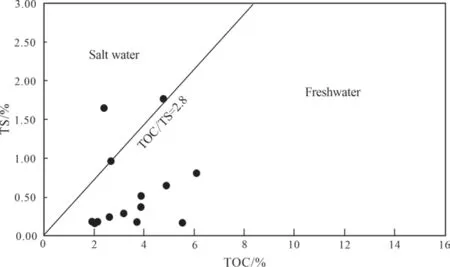
Fig.12 TOC-TS intersection of Longmaxi Formation in western Hubei
Gammacerane is a characteristic triterpene marker among pentacyclic triterpenes. This compound comes from tetrahymenol in protozoa (Fuet al., 1991). Gammacerane is often used to indicate the water salinity environment during organic matter deposition. It is generally believed that if the gammacerane index is less than 0.2, it can be identified as freshwater environment, between 0.2–0.3, it can be identified as brackish water environment, and if it is greater than 0.3,it can be identified as saline water environment (Chenet al., 2022). The samples in Western Hubei are rich in gammacerane, with the ratio ranging from 0.11–0.21,and the average value is 0.16. The gammacerane index of most samples is less than 0.2, and that of individual samples is slightly greater than 0.2 (Table 3). It shows that the formation environment of source rocks in the study area is not entirely freshwater environment, but mainly brackish water.
6 Conclusion
(1) The bottom lithology of Longmaxi Formation of Lower Silurian in Western Hubei is mainly dark carbonaceous shale, the middle is mainly grayish black and yellowish green shale, the upper lithology is mainly gray and grayish green silty shale, the mineral composition is mainly clay minerals, quartz and feldspar, the content of illite and kaolinite is high, and a small amount of strawberry pyrite and graptolite fossils.
(2) The total organic carbon content (TOC)of Longmaxi Formation in western Hubei is 0.8–6.32%, the average value is 3.42%, and the vitrinite reflectance (R0) is 1.57–2.95%. The type of organic matter is mainly type Ⅱ2. The overall organic matter abundance is high, which has a good material basis for the formation of shale gas and a high degree of thermal evolution. It has reached the stage of high maturity over maturity, and has a good material basis and conditions for the formation of shale gas.
(3) The comprehensive analysis results of organic maceral parameters and biomarkers show that the organic matter in Longmaxi Formation is a mixed source of planktonic algae and bacteria, and the large amount of hopane also indicates the strong bacterial activity in the period of organic matter deposition. The water body of the ancient lake is freshwater environment as a whole and brackish water environment in some parts. The redox property of the water body fluctuates little, and the whole is in a strong reduction environment. The water body has a certain stratification,which is also conducive to the preservation of organic matter.
Acknowledgements
Thanks to the Paleontological Research Center and Geochemistry Laboratory of Changjiang University for providing the experimental site, as well as the cooperation and support provided by China United Coalbed Methane Co., Ltd.
杂志排行
Global Geology的其它文章
- Late Triassic flora of the northern part of the Fore-Caspian depression (Kazakhstan) as exemplified by data from the S. Nurzhanov-509 borehole
- Glossopterids survived end-Permian mass extinction in North Hemisphere
- The first occurrence of Scincomorpha lizard from Nenjiang Formation (lower Campanian) of Jilin, Northeast China
- Characterization of mineral element fingerprints under soilcrop systems in eastern and western rice-producing areas of Jilin Province, China
- Unveiling Ceremony of Academician Li Xingxue’s Former Residence Scientists’ Spiritual Education Base held in Chenzhou of Hunan
- CONTENTS
